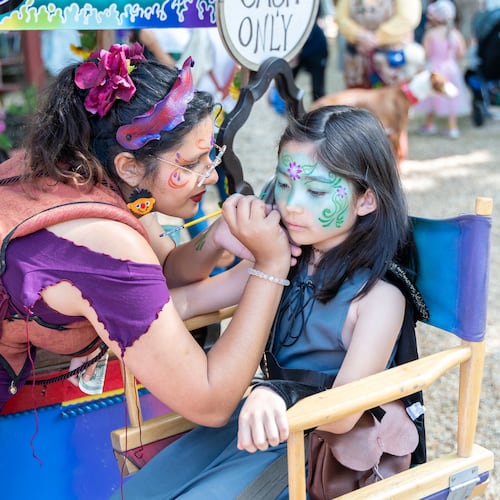ART REVIEW
“Carl Martin/Chris Verene: Affinities”
Through Nov. 15. 10 a.m.-7 p.m. Thursdays-Saturdays. Free. Opal Gallery, 88 Forsyth St. S.W., Atlanta. 770-999-9460, www.theopalgallery.com.
Bottom line: The most fascinating dimension to this show may be how it highlights not just the affinities, but the disparities in two talented photographers’ work.
Photographers Chris Verene and Carl Martin have a lot in common: Both hail from the South. Both favor juiced-up, color-saturated imagery. Both have a preference for showing the worn-at-the-elbows side of life: trailer parks, disheveled homes, pack rat workspaces and the people who dwell and work there. With so much to unite them, it’s surprising these kindred spirits haven’t shown together before this matchup at downtown’s Opal Gallery.
“Carl Martin/Chris Verene: Affinities” is a welcome opportunity to look at these simpatico artists side by side. Though much of the show’s curation can feel like a hodgepodge, uniting black-and-white and color work, older and newer pieces, the best part of “Affinities” is seeing not just what Martin and Verene have in common, but what sets them apart despite those similarities.
Verene, who grew up in Atlanta and is now based in New York City, has tackled a variety of topics in his work, but perhaps his most resonant project documents the residents of his family’s hometown in Galesburg, Ill. For several decades, Verene has returned to the town to chronicle the ups and downs (but more often, downs) of these citizens of an economically struggling corner of America. Broken families and poverty abound, along with moments of celebration and friendship.
Athens-based Martin, who was born in Limestone County, Ala., and received his art school education in New York City, meanwhile documents the fascinating array of some of Athens’ more bohemian, idiosyncratic citizens. “It’s all about authenticity,” Martin has said of his photographs, which hold true to that mission of capturing people who appear to live life on their own terms.
Unlike so many images of the South, Martin also captures something authentic and seductive about the region itself: a lush, wild flavor and hot house glamour as present in people as in the verdant backdrops of the kudzu-draped landscape. Whether he’s photographing the unabashedly vamping, flamboyant pose of a black car mechanic or the casual elegance of a long-legged woman sitting in her leafy backyard sipping a beer in “Sara at Home,” Martin endows his subjects — young, old, black, white — with a sense of agency and self-possession. Martin captures something of the South’s no-holds-barred eccentricity with warmth and a certain amount of sex appeal, allowing these unique people and the flavor of the region to come through.
Martin tends to separate people from circumstance and conveys the singularity and character of their lives despite their tatty surroundings, while Verene’s photographs are often laced with tragedy. There is a different flavor of far less self-possessed oddness in Verene’s images of people saddled with poverty and chaotic home lives. “Cheyenne” is a case in point, a shot of a forlorn-looking preteen in bedroom slippers appearing as if she’s harvesting her day’s outfit from the scruffy backyard clothesline.
In his poignant images, Verene is especially attuned to children, who can often come across as tragic chess pieces in adult dramas or as the unfortunate victims of their economic circumstance.
Despite his emotional, familial investment in Galesburg, Verene can give the sense of an outsider looking in on this strange milieu. In contrast, Martin’s vantage feels more like an insider’s holding a beer in one hand as he snaps a photo with the other before joining the party.
About the Author
The Latest
Featured
